Rottweiler
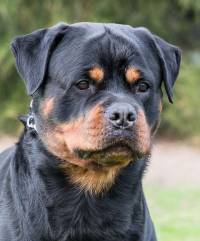 Rottweiler
Rottweiler
The Rottweiler is a self-assured, steady and fearless medium to large sized dog, neither heavy nor light, and neither leggy nor weedy. Good-natured and placid, he is obedient, biddable and eager to work. His appearance is natural and rustic and his behaviour self-assured, steady and fearless. He reacts to his surroundings with great alertness but at the same time is always even tempered.
History of the Rottweiler
 Roman Mosiac c AD 194
Roman Mosiac c AD 194
Rottweiler history can be traced back to Rottweil, a settlement founded in AD 73 at the junction of several ancient Roman military trading routes. Rottweil was the first town to be established in the Province of Germania which is now in Southern Germany. Evidence of Rottweil's antiquity are Roman baths and a mosaic dated 194 AD, similar to the one pictured of Orpheus playing his lyre, attracting birds and animals of many species[1].
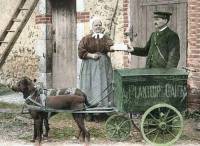 Historical Rottweiler
Historical Rottweiler
One of these trading routes was north over the Alps via the St Gotthard Pass. The Romans took cattle with them, together with their experienced driving and herding dogs. These dogs were mixed with purpose bred dogs met along the way, including those from the North and the forerunners of the Bernese Mountain Dog. Then indigenous hunting dogs like the German Boarhound and later, the Bullenbeisser were added to this mix. Meanwhile the village called Rottweil had grown into a Roman municipality which gave its citizens the privileges of Roman citizenship and the right to live according to their own laws and customs[1a].
 Rottweiler Herding
Rottweiler Herding
With the fall of the Roman Empire, Rottweil became one of the largest centers of trade in cattle in Europe. Driving herds of cattle and sometimes also sheep to and from this famous market needed a quiet reliable dog with considerable physical strength. So the purpose-bred dog of Rottweil became famous beyond the borders of his homeland. He was then used not only as a herding dog, but also as a guard and draft dog. At that time, strong dogs were commonly used for delivering products such as milk. This occupation ensured the preservation of the Rottweilers' physical strength until its development as a pure breed. Rotteil remains proud of being the birthplace of the Rottweiler, erecting the statue photographed below in its streets[1b].
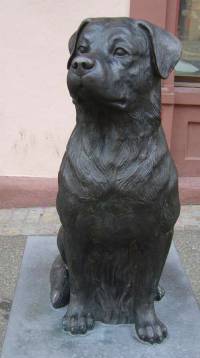 Rottweiler Statue
Rottweiler Statue
The Rottweiler becomes a Pure Breed
The first Rottweiler Breed Standard was written in 1901 with the breed making its debut at the Heidelberg Show in 1905. Billed as 'a fine dog of unusual breed and irreproachable character', his excellent qualities encouraged other enthusiastic admirers to found the German Rottweiler Club in 1907. The breed progressed so much that the Club became affiliated to the German Police Dog Association.
By 1926, around 40 regional Rottweiler Clubs were formed across Germany as well as some in Europe. So a General German Rottweiler Club, the ADRK was created to oversee the future development of the breed. Amazingly, the unity of the ADRK and the reputation of the Rottweiler himself survived all the political turmoil of the Second World War[1c]. It was written:
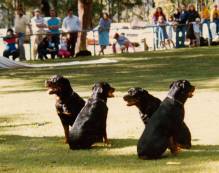 Obedience Demonstration
Obedience Demonstration
'During the war, there was an inevitable recess in the breeding and keeping of Rottweilers.... many Rottweilers of value for breeding had to be handed over for active service.... wherever Rottweilers, well-trained and handled were assigned to duties appropriate to their abilities, they acquitted themselves well and gained credit for the breed'[2].
After the Second World War, the ADRK revised the original Breed Standard and submitted it to FCI which first approved it in 1967[3].
History of Rottweilers in Australia
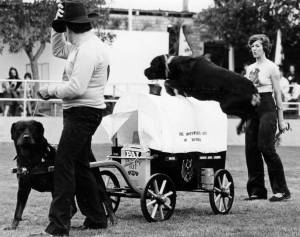 Rottweiler Leaping over dog-cart
Rottweiler Leaping over dog-cart
The credit of introducing and initially promoting the Rottweiler in Australia lies with Mr Doug Mummery. Already involved in police training, in 1958 he first selected a dog from UK with the conformation and temperament he was aiming to introduce here. But sadly, this dog died from heat exhaustion en route by ship to Australia. Fortunately, in 1962 Captain Roy Smith emigrated from England bringing with him a Rottweiler dog and bitch. Mr Mummery purchased a bitch from Roy Smith's first litter and later imported a dog[4].
The Rottweiler Club of Victoria was founded in 1971. During their early years, in addition to holding Championship and other Shows, they were committed to promoting the Rottweiler's working ability. In the days before Agility, carting and other active disciplines became popular here, Obedience was the only formal training activity. To this end, the Rottweiler Club conducted not only its own Restricted Obedience Trial, but uniquely another open to all breeds.
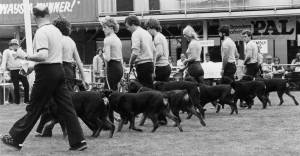 Rottweiler Club Demonstration Team
Rottweiler Club Demonstration Team
In their early years, the Victorian Rottweiler Club conducted demonstrations which promoted the Rottweiler and highlighted their willingness to be trained. These demonstrations were conducted at many public events. Teams of Obedience trained Rottweilers participated in marches through our crowded Melbourne streets, paraded around the main ring at the Royal Melbourne Show, and gave demonstrations at many other public functions. This popularised the Rottweiler in here, giving the general public the impression that, when well trained and handled, Rottweilers acquit themselves well in any situation.
Comparison between the Rottweiler and the Bernese Mountain Dog
These two modern breeds are considered here together because they have a common origin and purpose. In Roman times their ancestors drove cattle along ancient trading routes north from Italy over the Alps via the St Gotthard Pass to Switzerland and Southern Germany. Centuries later, both breeds were used for carting.
| Rottweiler | Bernese Mountain Dog | |
|---|---|---|
| General Appearance | The Rottweiler is a powerful, double coated, black and tan dog standing 56 - 68 cm tall. | The Bernese is a longhaired, tricoloured, agile working dog, standing 60 - 70 cms tall. |
| Temperament | Alert, self-assured and eager to work. | Outgoing friendliness. |
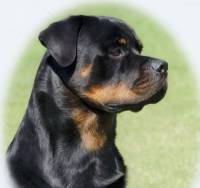 Rottweiler Rottweiler |
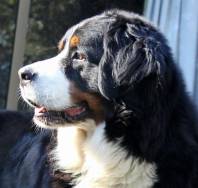 Bernese Mountain Dog Bernese Mountain Dog |
|
| Skull | The relatively broad skull is of medium length with pronounced cheek bones or zygomatic arches. In profile, the forehead is moderately arched and the occipital bone visible. |
The head is strong in balanced with its general appearance without being too massive. Viewed from the front and in profile the skull is slightly rounded with the frontal furrow hardly visible. |
| Stop | The stop relatively well defined with a frontal groove that should not be too deep. | The stop is well defined, but not too deep. |
| Muzzle | The ratio between the length of the muzzle to that of the skull should be 1:1·5. The straight nasal bridge is broad at the base, moderately tapered, with dark, close fitting lips. | The nose is black, the muzzle strong and of medium length and the nasal straight. The lips must always be tight fitting and black. |
| Eyes | The almond shaped dark brown eyes are of medium size, with eyelids close fitting. | The almond-shaped, dark brown eyes have close fitting eyelids and are not deep-set or prominent. |
| Ears | The medium sized triangular shaped ears are set high and wide apart. When alert they make the skull appear broader. | The medium-sized, high set triangular shaped ears have slightly rounded tips. When alert, the rear part of the ear is raised while the front edge of the ear remains close to the head. In repose they hang flat and close to the head. |
| Mouth | A normal scissors bite with complete dentition. | A normal scissor bite. A level bite is acceptable with full dentition preferred. |
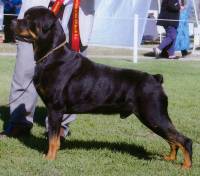 Rottweiler Rottweiler |
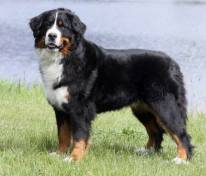 Bernese Mountain Dog Bernese Mountain Dog |
|
| Neck | Strong and muscular, of fair length without excessive dewlap. | Strong and muscular of medium length. |
| Forequarters | From the front, the chest is broad and deep so the legs are not placed too closely together. The foreleg is straight and vertical, the shoulders sloping at about 45 degrees to the horizontal and the elbows close fitting.The pasterns are springy with some slope. | From the front, the chest is broad and deep, reaching to the close-fitting elbows with the forechest distinctly developed. The shoulder blade and upper arm are long and set obliquely. The forelegs are strong and vertical with almost upright pasterns. |
| Feet | The front feet are round, tight and well arched with hard pads and short, black and strong nails. The back feet are slightly longer. | The front feet are short and round, with well-knit, well-arched toes. The hind feet are slightly less arched. |
 Rottweiler Rottweiler |
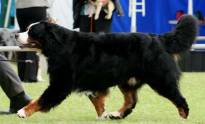 Bernese Mountain Dog Bernese Mountain Dog |
|
| Body | The back is straight, strong and firm, the loins strong and deep and the croup is broad and of medium length and slightly rounded. The belly should not be tucked up. | The topline runs slightly downwards from the neck to the withers. It is then a firm, straight and level harmonious line running to the broad, strong loins and smoothly rounded croup into the tail. |
| Hindquarters | Seen from behind, the hind legs should be not too close together. In profile, obtuse angles form the dog's stifle, his moderately long upper thigh and the hip bone, the upper thigh and the long and sinewy lower thigh, and the lower thigh and sturdy, well angulated hock. | Viewed from the rear, the legs should be straight and parallel, but not too close. The upper thigh is long, broad, strong and well muscled and the stifle well bent. The lower thigh is long and oblique and the well angulated hock joint is set almost vertically with dewclaws removed (except in those countries where it is prohibited by law). |
| Tail | The undocked tail is set-on level with the the topline. When exited or moving it can be carried upward in a slight curve. At rest hangs reaches the hocks or a bit longer. | Bushy, reaching at least to the hocks; hanging straight down when at rest but carried level with back or slightly above when moving. |
| Coat | The double coat consists of a top dense, flat top coat of medium length through which the undercoat must not show. The skin should be tight fitting but wrinkles on the forehead when alert, are typical. | Long and shiny, straight or slightly wavy. |
| Colour | Black with clearly defined markings of a rich tan on the cheeks, muzzle, throat, chest and legs, over both eyes and around the vent. |
Essentially a black dog with rich tan markings on the cheeks, above the eyes, on all four legs and on the chest, and with specific white markings. |
| Movement | A trotting dog, moving with his topline remaining firm and relatively stable. His movement is typically harmonious, full of energy with a steady, unrestricted stride. | The movement is sound and balanced with free strides covering a lot of ground, moving forward in a straight line. |
References and Further Reading
[1] Manfred Schänzle - 'Studies in the Breed History of the Rottweiler', translated by John H Mavphail, England and published jointly by the Colonial Rottweiler Club and the Medallion Club. Chapter 1 Origin, Decent and History of the Rottweiler Page 1
[1a] Ibid., Chapter 1 - Origin, Decent and History of the Rottweiler Page 2
[1b] Ibid., Chapter 1- Origin, Decent and History of the Rottweiler Page 4
[1c] Ibid., Chapter 2 - Establishment of Breed Societies Page 8
[2] H. Korn - 'Der Rottweiler' Published: O.Meisser, Schloss Bleckede Elbe 1955
[3] Adolf Pienkoβ - 'The Rottweiler' Published by Helga Broekeland Publishing Company, Essen Germany
[4] Pat Hall - "The History of Purebred Dogs in Australia" The Rottweiler. Published by OzDog Newspaper 1997 Page 225